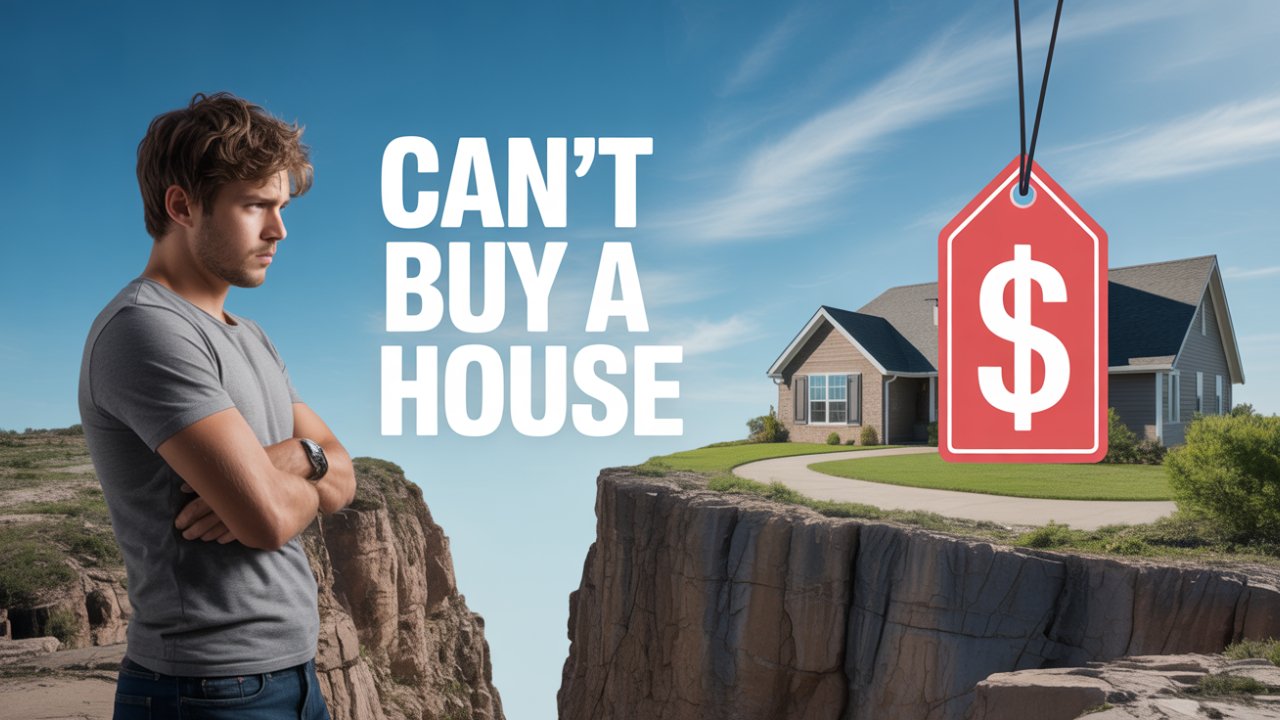In the 1960s, the median American home cost just over two times the median family’s annual income. Think about that. A couple of years of work, and you could afford the American Dream. Today, that ratio isn’t two. It’s not even three or four. For most of the 20th century, a house cost around three times the yearly household income, but in the last two decades, that number has shot past five and is still climbing. If you feel like you’re in a race where the finish line keeps moving further away, you’re not imagining it. You’re not a failure. You’re not bad with money. You are a character in a story that began decades before you were born. A story of quiet policy changes, massive economic shifts, and a fundamental rewriting of the rules of wealth in this country.
You’ve been told a simple story: work hard, save money, and one day, you’ll buy a house. It’s the cornerstone of the American Dream, a symbol of stability, and a way to build generational wealth. But for millions, that story has become a cruel fantasy. You followed the rules. You got the degree, you found the job, you diligently put money aside. And yet, when you look at the housing market, it feels like staring across an impassable canyon. On one side, there’s you, with your hard-earned savings. On the other is a home with a price tag that has soared into the stratosphere, completely untethered from the reality of your paycheck.
This isn’t an accident. This is a design. The fact that an entire generation is being systematically locked out of homeownership is not the result of too many lattes or a lack of savings. It is the predictable, calculated outcome of a half-century of decisions made in boardrooms and legislative chambers. It’s a story about supply, demand, money, and power. And to understand why you can’t buy a house, you have to understand how the world really works. This isn’t just about real estate. It’s about the erosion of the middle class, the widening chasm of the wealth gap, and the quiet dismantling of a promise once available to all. So, let’s pull back the curtain, follow the money, and uncover the real reason the deck feels so completely and utterly stacked against you.
To understand this crisis, you first need to understand the most basic law of economics: supply and demand. If there’s a lot of something, it’s cheap. When there’s not enough to go around, it gets expensive. For the last several decades, America has been engaged in a slow-motion catastrophe: we have simply failed to build enough houses. It’s not a glamorous problem, it doesn’t make for exciting headlines, but it is the bedrock of our current affordability crisis.
Let’s be clear: we are in a severe housing shortage. It’s estimated that the U.S. is short by nearly 4 million homes, and some analyses show a deficit of over 7 million affordable units. This isn’t a new problem. It’s the result of more than a decade of underbuilding compared to population growth. Think of it like a game of musical chairs. Every year, more people join the game, but instead of adding more chairs, we’ve been slowly taking them away. The music stops, and millions are left standing.
So why did we stop building? The answer is a perfect storm of factors. First, the 2008 financial crisis blew a hole in the construction industry. The housing bubble popped, builders went bankrupt, and a generation of skilled labor left the trades, many never to return. In the aftermath, new construction slowed to a crawl and never truly caught up to the demand that was quietly building in the background. This created a deficit, a hole in our housing stock that we’ve been digging deeper ever since.
But the 2008 hangover is only part of the story. The other, more insidious culprit is a web of local rules known as zoning laws. Originally, zoning was for orderly city planning keeping factories away from schools, for example. But over time, it’s become a powerful tool for exclusion. In city after city, the vast majority of residential land is zoned exclusively for single-family homes. This means on a huge plot of land, you can only build one, often very expensive, house. Forget duplexes, triplexes, or small apartment buildings the kind of “missing middle” housing that provides more affordable ways into a neighborhood. It’s simply illegal to build them.
These restrictions act as a chokehold on supply. When you limit how many homes can be built on a finite amount of land, you artificially drive up the value of both the land and the homes that sit on it. It’s basic math. If a one-acre lot can only hold one house instead of, say, four townhomes, the price of that single house will inevitably be astronomical. Developers aren’t incentivized to build affordable starter homes because the regulations and land costs make it unprofitable. They’re forced to build luxury homes to make the numbers work, leaving a massive gap in the market for everyone else.
This is often fueled by NIMBYism the “Not In My Backyard” mentality. Existing homeowners, worried about property values or the “character” of their neighborhood, lobby local governments to block new, denser housing developments. They fight against apartment buildings and townhomes, effectively pulling up the ladder behind them. They benefit from the scarcity these laws create, as it drives up the value of their own homes. The result is that our most vibrant cities, the ones with the most jobs, become exclusive enclaves, accessible only to the wealthy. The supply of new homes is strangled, not by a lack of space or demand, but by deliberate policy choices.
Adding to this storm are the soaring costs of actually building a house. The price of lumber, steel, and other materials has become incredibly volatile, while a persistent labor shortage continues to drive up construction wages. So even when a developer gets the green light, the cost to put shovels in the ground is higher than ever.
So this isn’t a free market at work. It’s a market that has been intentionally and systematically constrained for decades. We are living with the consequences of our collective failure to build. We have created a national housing landscape with historically low inventory, where too many people are competing for too few homes. And when that happens, prices can only go one way: up.
The chronic shortage of housing lit the fuse. But the explosion that sent prices into orbit was a combination of economic forces that have relentlessly squeezed the average person’s ability to keep up. It’s a two-front war: while the cost of a home has skyrocketed, wages have stagnated, and the cost of borrowing money has become a crushing burden.
Let’s start with the sticker shock. Home prices have risen to levels that would have been unimaginable a generation ago. Since 1960, after adjusting for inflation, the median home price in the United States has increased by a staggering 121%. Over that same period, median household income has only risen by 29%. The gap between what we earn and what a home costs has become a chasm. The numbers tell a brutal story. In the 1960s, the price-to-income ratio was around 2.1. Today, that ratio is over 5, and in many desirable cities, it’s closer to 8 or 9.
This isn’t just an abstract economic indicator. It has profound, real-world consequences. It dictates how many decades you have to save for a down payment. Back in the 1960s, a 20% down payment was a manageable fraction of a family’s annual income. By 2025, that same 20% down payment requires over 100% of the median household’s yearly income. You now need more than a full year’s salary, with zero other expenses, just for the down payment. It’s an impossible hurdle for most people, especially when rising rents are eating away at any potential savings.
But the price tag is only half the equation. The second, and arguably more painful blow in recent years, has been the surge in mortgage rates. For years, low interest rates helped to mask the pain of rising prices. But those days are over. After hitting record lows under 3% during the pandemic, rates surged, at times exceeding 8% for the first time in over two decades. As of mid-2025, the 30-year fixed rate is hovering around 6.6 to 6.8 percent, more than double what it was just a few years ago.
It’s hard to overstate how devastating this is for affordability. A higher interest rate doesn’t just add a little to your monthly payment; it can add hundreds, or even thousands, of dollars. Consider a $400,000 mortgage. At a 3% interest rate, your monthly principal and interest payment is about $1,686. At 7%, that same loan costs you $2,661 a month. That’s nearly a thousand dollars extra, every single month, for thirty years. That single change is the difference between affording a home and being locked out completely. It has pushed the monthly cost of owning a home to a record share of the median household income, making it impossible for many to even qualify for a loan.
So you have a perfect storm. Prices are at or near all-time highs. And the cost to borrow the money to pay those prices is also painfully high. You’re caught in a financial vise. Your wages aren’t keeping up with the price of the asset, and the cost of financing that asset has exploded. This is the mathematical reality that confronts every aspiring homebuyer today. It explains why, even if you’ve managed to save a down payment, the monthly numbers just don’t work. The system is no longer calibrated for the average worker. It is calibrated for those who already have wealth, which brings us to the next, crucial piece of the puzzle.
This crisis isn’t just about money; it’s about timing. When you were born has become one of the single biggest determinants of your ability to build wealth in America. The housing market that your parents or grandparents entered looks nothing like the one that Millennials and Gen Z are facing today. This isn’t about blaming older generations; it’s about understanding the profoundly different economic landscapes they navigated and how government policy actively helped them succeed in a way it no longer does.
For much of the mid to late 20th century, especially for the Baby Boomer generation, the wind was at their backs. They entered a housing market with plentiful supply and low prices relative to their incomes. Government policies were explicitly designed to promote homeownership. Programs like the GI Bill offered returning veterans low-interest, zero-down-payment mortgages, opening the door for millions to buy their first home and begin building equity. The federal government invested heavily in infrastructure and subsidized the development of the suburbs, creating entire communities of affordable single-family homes.
For decades, buying a house was a reliable, almost automatic way to build wealth. Interest rates were manageable, and property values rose steadily but predictably. A person could get a stable job, buy a home, and trust that their single biggest asset would appreciate over time, funding their retirement or providing a nest egg to pass on to their children. For Baby Boomers, the homeownership rate at age 27 was over 40 percent.
Now, contrast that with the experience of Millennials and Gen Z. They entered the workforce often saddled with historic levels of student loan debt, only to face a housing market that had already been warped by decades of undersupply and financial speculation. They are confronted with a homeownership rate that has flatlined. For 27-year-olds today, that rate is just 33%, significantly lower than it was for Boomers at the same age. It’s not because they are less ambitious or less responsible. It’s because the fundamental mechanics of the game have changed.
The “starter home” of the past has all but vanished, replaced by properties costing five, six, or seven times the median salary. The government support that previous generations enjoyed has largely evaporated. Instead of federal programs making it easier to buy, chronic underfunding of affordable housing initiatives has made it harder. The result is a stark and widening generational wealth gap. Older generations, who bought into the market when it was affordable, have seen their net worth balloon as property values soared. They hold the vast majority of the country’s real estate wealth.
Younger generations are largely on the outside looking in. For many, the only path to homeownership is through the “bank of mom and dad,” relying on family wealth to scrape together a down payment. This only serves to entrench existing inequalities, creating a new kind of landed gentry where the dream of ownership is inherited, not earned. The societal consequences of this shift are profound. It is delaying major life milestones marriage, children, and financial independence. It is forcing a huge number of young adults to live with their parents well into their late 20s and 30s, simply because they have no other affordable option.
This isn’t a level playing field. It’s a field that has been tilted, for decades, in favor of those who got there first. The wealth that younger generations were supposed to build through homeownership is instead being captured by those who already own property. The social contract that promised upward mobility through hard work has been broken. The ladder has been pulled up, leaving an entire generation feeling stuck, frustrated, and questioning the very foundations of the American Dream.
While supply shortages and generational timing are critical parts of this story, there is another powerful force at play: the financialization of housing. This is the story of how a house stopped being primarily a home and became just another asset class, like stocks or gold, to be traded by massive corporations for profit. This shift has fundamentally altered the market, pitting regular families against some of the most powerful financial players in the world.
The trend began in earnest after the 2008 housing crash. When millions of homes were foreclosed upon, large institutional investors private equity firms, hedge funds, and Real Estate Investment Trusts, or REITs saw an opportunity. They swooped in and bought up tens of thousands of single-family homes at bargain-basement prices. Their goal wasn’t to live in these houses, but to rent them out, creating a new, large-scale single-family rental market.
On the surface, this might not sound so bad. But the long-term consequences have been toxic for affordability. These firms have access to vast pools of capital. They can pay in cash, waive inspections, and outbid regular homebuyers with ease. In many desirable neighborhoods, families looking for a place to live found themselves competing directly with faceless corporations armed with billions of dollars. They never stood a chance.
The presence of these large investors has been shown to reduce the supply of homes available for purchase, converting them into rental properties instead. And while some argue their overall market share is nationally small, their impact is highly concentrated in specific, fast-growing areas, effectively setting the price for entire neighborhoods and pushing homeownership further out of reach. This is especially true in minority communities, which have been disproportionately targeted by these investment strategies.
This corporate consolidation of housing is a symptom of a much larger policy failure. For decades, federal and state governments have failed to adequately fund programs that support affordable housing. Budgets for crucial initiatives have been stagnant or cut, and federal housing assistance only reaches about one in four eligible households. We have essentially disinvested in housing as a public good, while creating a tax environment that favors corporate ownership and real estate speculation. There is simply more incentive to build luxury condos and profit-driven rental communities than there is to build modest, affordable homes for working families.
Furthermore, systemic inequalities are baked into the very foundation of our housing system. Racial and income disparities are not just a byproduct of the crisis; they are a central feature. Households of color are far more likely to be cost-burdened by housing and face significant barriers to homeownership. This is the legacy of decades of discriminatory practices like redlining, which, though illegal now, carved deep inequalities into our cities that persist to this day.
Finally, we are beginning to see the impact of external shocks like climate change. As floods, fires, and storms become more frequent and severe, the cost of insuring a home is skyrocketing in many parts of the country, pushing it out of reach for even more people.
All of these forces the rise of corporate landlords, the retreat of public investment, deep-seated inequalities, and new climate risks are pulling the strings of the housing market. They have created a system that no longer prioritizes the basic need for shelter. Instead, it prioritizes profit. It’s a system where a regular family’s dream of owning a home is often no match for a Wall Street firm’s demand for a 12% return on investment. You aren’t just competing with other families anymore. You’re competing with global capital.
Hearing all of this, it’s easy to feel overwhelmed, even hopeless. The forces aligned against the average homebuyer are immense and have been building for decades. But understanding the problem is the first and most crucial step toward fixing it. While there is no single magic bullet, there is a clear path forward a combination of bold policy changes, local action, and a fundamental shift in how we think about housing.
First and foremost, we must aggressively tackle the supply crisis. This is the root of the problem, and it requires a direct challenge to the restrictive zoning laws that have crippled our ability to build. Cities and states must move to end single-family-only zoning and allow for more diverse housing types. We need to legalize the “missing middle” duplexes, triplexes, townhomes, and small apartment buildings in all neighborhoods. This isn’t about building skyscrapers in quiet suburbs; it’s about gently increasing density in a way that creates more options and price points for more people. States can and should step in when local governments refuse to act, because housing affordability is a statewide economic issue.
Alongside zoning reform, we need a massive, coordinated effort to build. This means expanding financial tools like the Low-Income Housing Tax Credit to better incentivize the construction of homes that are genuinely affordable to low and middle-income families. It also means supporting innovative and lower-cost construction methods, like manufactured and modular housing, which can be built more quickly and efficiently.
Second, it’s time to rethink the policies that have fueled the financialization of housing. This could include measures that disincentivize large-scale corporate purchases of single-family homes, especially in overheated markets. The goal should be to level the playing field, to ensure that families looking for a place to live aren’t consistently outbid by investment firms looking for a return. We must shift the balance back toward housing as shelter, not just as a financial instrument.
Third, the federal government must recommit to housing as a priority. This means robustly funding federal housing programs and rental assistance to ensure that help reaches everyone who qualifies. For decades, these programs have been chronically underfunded, and it’s time to treat the housing crisis with the urgency it deserves. This is not just a social issue; it’s an economic one. A nation where people spend more than half their income on housing is a nation with less consumer spending, less entrepreneurship, and less economic dynamism.
Finally, and perhaps most importantly, change starts at the local level. It’s your city council and your county commission that make the decisions about what can be built and where. Get involved. Show up to zoning meetings. Support pro-housing candidates and policies. Advocate for more housing of all types in your own neighborhood. The narrative that new housing is something to be feared must be replaced with the understanding that it is essential for the health and vitality of our communities.
For individuals caught in this crisis, the immediate options are limited. People are exploring alternative paths like co-buying with friends or family, or looking into real estate crowdfunding to build equity. But these are workarounds, not solutions. They don’t fix the underlying, systemic problem. The true path forward isn’t just about finding a clever way to beat the system; it’s about demanding that the system be changed.
If this story resonates with you, if you’ve felt the frustration of doing everything right and still feeling locked out, share your experience in the comments below. Your story is part of a larger, national conversation that needs to be had. And while you’re there, subscribe and hit the bell so you don’t miss our next deep dive into how the world really works.
The inability to buy a house in America today is not your fault. Let that sink in. It is not a reflection of your work ethic, your ambition, or your financial literacy. It is the result of a half-century of deliberate choices that have prioritized the accumulation of wealth for a few over the stability and prosperity of the many.
It’s the result of a chronic, manufactured housing shortage, born from restrictive laws that have made it illegal to build the homes we need. It’s the result of an economic decoupling, where home prices soared into the stratosphere while your wages were left behind on the tarmac. It’s the result of a generational chasm, where the opportunities afforded to one generation were not passed down to the next. And it’s the result of a system that increasingly treats a fundamental human need as a speculative commodity on a global market.
The dream of a home wasn’t lost by one generation; it was sold off, piece by piece, over decades. We have allowed the rules to be rewritten, the ladder to be pulled up, and the promise of a secure future to be replaced by the anxiety of perpetual rent. But the first step to rewriting those rules is understanding them. The anger and frustration you feel is valid. It is a righteous response to a broken system. The real question is not why you can’t buy a house. The real question is, what are we all going to do to build a country where you can?





